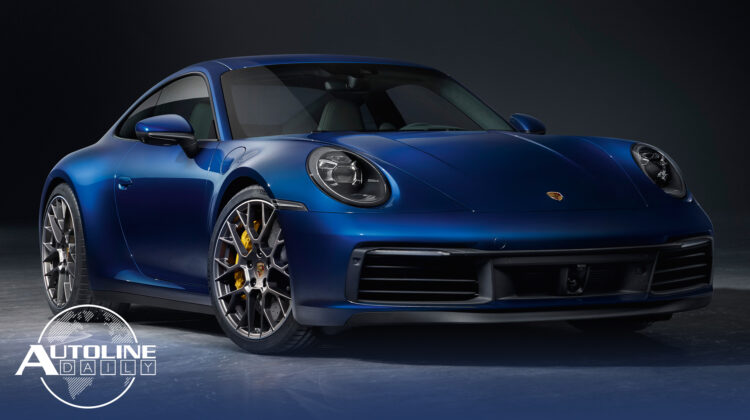
Follow us on social media:
Runtime: 7:57
0:29 Porsche 911 Gets More Sporty
1:40 Honda Revives the Passport
2:24 Rivian Reveals Electric SUV
3:10 Mazda3 Features More Upscale Styling
3:48 Lincoln Takes the Wraps Off the Aviator
4:39 Toyota Prius Now Available with AWD
5:10 Corolla Hybrid Makes U.S. Debut
6:05 Bosch Brings Automated Driving Closer to Reality
Visit our sponsors to thank them for their support of Autoline Daily: Bridgestone , Dow Automotive Systems , Lear Corporation , and ExxonMobil.
On today’s show…the ultimate sports car gets sportier…Lincoln blasts off into the mid-size crossover segment…and Bosch makes sure autonomous cars know exactly where they’re at, at all times. All that and more coming right up on Autoline Daily.
This is Autoline Daily the voice of the automotive industry.
PORSCHE 911 GETS MORE SPORTY
Porsche has revealed the 8th generation 911. Let’s look at the highlights. The fenders are wider than before and the front track has been pushed out close to 2-inches. The door handles are flush mounted to help emphasize the body lines on the side. And at the rear, the new 911 has a wider spoiler and light bar, which is more in line with the Panamera and Taycan. Power comes from the next generation of its turbocharged flat-six engine. Rated at over 440-horsepower, it makes nearly 30-horsepower more than the outgoing model, which helps reduce 0 to 100 kilometers time by almost half a second. Rear drive versions do it in 3.7 seconds, all-wheel drive in 3.6-seconds. 1970’s models inspired the interior with clear, straight lines across the dashboard and recessed gauges. A large 10.9-inch display screen sits in the middle of the interior as well. The new 911 starts at just over $114,000 in the U.S. and will hit dealer showrooms in the summer of next year.
HONDA REVIVES THE PASSPORT
Honda is upping its SUV game by reviving the Passport, which will slot between the CR-V and 3-row Pilot in its lineup. It looks a lot like a baby version of the Pilot as many of the styling cues were taken right from the larger utility vehicle. It’s of unibody construction and features fully independent suspension. Only one engine is available, a 280-horsepower 3.5L V6, which gets mated to a 9-speed automatic transmission. All-wheel drive is also available. A 5-inch display comes standard, but higher trim levels get an 8-inch screen. All models feature a 7-inch instrument cluster.
RIVIAN REVEALS ELECTRIC SUV
And speaking of SUVs, we told you you’d be hearing more about EV startup Rivian, which just revealed its electric SUV. The specs are the same as the truck, so there’s not much to talk about there. But the styling is a bit different with some minor tweaks to the front fascia and flatter body sides. We actually think it kind of looks like a futuristic Cadillac Escalade.
And we’ll be back with more reveals from LA, right after this.
MAZDA3 FEATURES MORE UPSCALE STYLING
Mazda revealed the new Mazda3. The styling has been updated and features a more upscale look. It’s the first vehicle in the company’s lineup to offer its new spark-controlled compression ignition engine, what it calls SkyActiv-X. Three gasoline engines are also available, as well as a 1.8L diesel. The engines can be mated to a six-speed manual or six-speed automatic transmission. And it’s now available with more safety and driver assistance features. The new Mazda3 goes on sale in North America in early 2019 and will be rolled out to global markets after that.
LINCOLN TAKES THE WRAPS OFF THE AVIATOR
Lincoln is jumping into the midsize, premium crossover segment with the all-new Aviator. The three row CUV is available with two powertrains. A twin-turbo 3.0L V6 that’s mated to a 10-speed automatic comes standard. And customers can choose a hybrid version, that uses the same engine, but it’s expected to produce over 450-horsepower and a whopping 600 lb-ft of torque. It also comes with some cool features. The suspension automatically lowers when the driver approaches the vehicle and will automatically adjust when driving over a pothole. Owners can also use their smartphone instead of a key fob, to unlock, lock, start and drive away in the vehicle. The new Lincoln Aviator will be sold in both the U.S. and China.
TOYOTA PRIUS NOW AVAILABLE WITH AWD
Toyota took the wraps off a couple of hybrids. It introduced an all-wheel-drive version of the Prius, which is expected to deliver 50 MPG combined. Just two less than front-wheel-drive models. It uses the same hybrid system as FWD models but it features a newly developed nickel-metal hydride battery, instead of a lithium-ion battery. The company estimates that the AWD version could account for as much as 25% of all Prius sales in the U.S.
COROLLA HYBRID MAKES U.S. DEBUT
The company also unveiled a hybrid version of the Corolla, the first time it’s available in the U.S. It features an adapted version of the Prius’s hybrid system. A 1.8L four-cylinder gasoline engine, with two motors, that’s mated to a CVT. Like the AWD Prius, it uses a nickel-metal hydride battery instead of a lithium-ion one. It’s projected to get at least 50 MPG combined. The Corolla Hybrid goes on sale in the U.S. in the spring of 2019.
Coming up next, Bosch creates a system to make highly automated driving a reality.
BOSCH BRINGS AUTOMATED DRIVING CLOSER TO REALITY
Before Level 4 and 5 autonomous driving becomes a reality, vehicles will need to know exactly where they are, at all times. And the German supplier Bosch has created a solution to allow for this. Its system uses surround sensors, satellite navigation and inertial sensors to determine the vehicle’s position on a high definition map. The surround sensors collect info about stationary surroundings like guardrails or signs. That data is sent to the Bosch cloud to make an independent map of the HD map. Both maps are then compared to give a more precise location of the vehicle. The car is also equipped with satellite sensors and those receivers determine its position from several satellites. To offset the effects of imperfections, like satellite orbits, satellite clock errors and atmospheric disturbances, the vehicle motion and position sensor uses signals provided by a correction service. The correction data is created by a network of reference stations, which receive signals and send them to a data processing center. The signals are then compared with reference stations to create detection data which is then sent to the vehicle. The vehicle motion and position sensors then process that data to determine the actual position of the vehicle. If the car goes through a tunnel and the signal is lost, inertial sensors in the car take over to determine where it’s at. Bosch believes the redundancy in its system is necessary for the car to always know where it’s at.
But that brings us to the end of today’s show, thanks for watching and please join us again tomorrow.
Thanks to our partner for embedding Autoline Daily on its website: WardsAuto.com

John McElroy is an influential thought leader in the automotive industry. He is a journalist, lecturer, commentator and entrepreneur. He created “Autoline Daily,” the first industry webcast of industry news and analysis.




